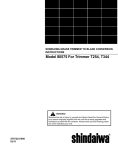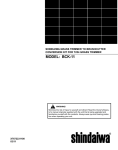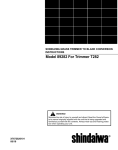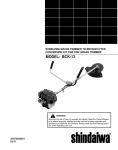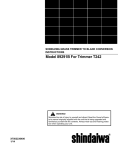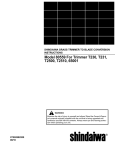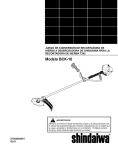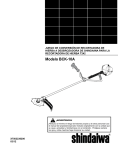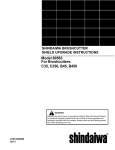Download Shindaiwa T344 Operator`s manual
Transcript
SHINDAIWA GRASS TRIMMER TO BLADE CONVERSION INSTRUCTIONS Model 80575A For Trimmer T235, T254, T344 WARNING! Minimize the risk of injury to yourself and others! Read the Owner's/Operator's manual originally supplied with the unit that is being upgraded and familiarize yourself with the contents. Always wear eye and hearing protection when operating your unit. X7672231800 06/13 Introduction These are instructions to convert a grass trimmer to a blade capable unit. This is not an Owner's/Operator's manual. Information on how to operate and maintain the unit can be found in the Owner's/Operator's manual for the unit you are converting. Note this kit is supplied with a cutting attachment shield that has been redesigned to provide better visibility and a larger cutting swath when used as a grass trimmer. Contents PAGE IMPORTANT! The information contained in these instructions describes the product available at the time of publication. Echo, Inc. reserves the right to make changes to products without prior notice, and without obligation to make alterations to units previously manufactured. PAGE PAGE Attention Statements.........................2 General Safety Instructions...............3 Assembly...........................................4 Safety Labels.....................................3 Kit Contents.......................................3 Shoulder Strap..................................7 Using a Brushcutter Blade.................8 Attention Statements Throughout this manual are special “attention statements”. WARNING! A statement preceded by the triangular attention symbol and the word “WARNING” contains information that should be acted upon to prevent serious bodily injury. CAUTION! A statement preceded by the word “CAUTION” contains information that should be acted upon to prevent mechanical damage. IMPORTANT! A statement preceded by the word “IMPORTANT” is one that possesses special significance. NOTE: Read and follow this operators manual. Failure to do so could result in serious injury. Wear eye and hearing protection at all times during the operation of this unit. Keep bystanders at least 50 feet (15 m) away during operation. Beware of thrown or ricocheted objects. A statement preceded by the word “NOTE” contains information that is handy to know and may make your job easier. IMPORTANT! The instructions described in this manual are intended to help you get the most from your Shindaiwa power tool as well as to protect you and others from harm. These procedures are guidelines for safe operation under most conditions, and are not intended to replace any safety rules and/or laws that may be in force in your area. If you have questions regarding your Shindaiwa power tool, or if you do not understand something in these instructions, your Shindaiwa dealer will be glad to assist you. You may also contact Shindaiwa at the address printed on the back of this instructional manual. 2 Do not operate this unit with a blade unless the unit is equipped with a Shindaiwa-approved handlebar or barrier. Always wear a harness when operating this unit with a blade. A harness is also recommended when using trimmer line. If unit is used as a brushcutter, beware of blade thrust. A jammed blade can cause the unit to jerk suddenly and may cause the operator to lose control of the unit. Safety Labels IMPORTANT! Safety and Operation Information Labels: Make sure all information labels are undamaged and readable. Immediately replace damaged or missing information labels. A new label is provided in this kit and additional labels are available from your local authorized Shindaiwa dealer. Prior to installing the new label, Remove old label and clean the outer tube with rubbing alcohol or similar cleaner. General Safety Instructions WARNING! ■■ALWAYS Shut off the engine immediately if a blade ■■When operating with a blade, make sure the handle binds in a cut. Push the branch or tree to ease the bind and free the blade. is positioned to provide you with maximum protection from contacting the blade. Always make sure the handlebar is installed in accordance with the manufacturers instruction. ■■Beware of a coasting blade when brushcutting or edging. A coasting blade can injure while it continues to spin after the throttle trigger is released or after the engine is stopped. ■■NEVER use a cracked or warped blade: If a properly installed blade vibrates, replace it with a new one and re-check. Kit Contents 1 15 16 6 4 5 12 5 6 13 2 14 3 11 8 10 7 #Description 1. Barrier Bar 2. Screw 5x10mm 3. Metal Shield 4. Shield Bracket 5. Spring Washer 5mm 6. Nut 5mm 7. Screw 5x8mm 8. Nut 10, left hand 9. Split Pin 2x22 10. Adapter Plate, lower 11. Adapter Plate upper 25mm 12. Harness Ring Assembly 13. Bolt 5x12mm 14. Shoulder Harness 15. Caution Label 16. Bolts 5x35, torx Assembly Tool (s) Qty. 1 3 1 1 4 4 2 1 10 1 1 1 1 1 1 2 9 3 Assembly Removing the Existing Cutting Attachment Shield C 1. If installed, remove nylon line head, adapter plate, shield plate, and plastic shield: a.Align locking hole in adapter plate with notch in edge of gear housing and insert locking tool (A). b.Remove line head (B) by turning it clockwise until head is completely off of shaft. c. Remove locking tool. d.Remove three screws holding shield plate (E) and plastic shield (C) to gear housing. e.Retain line head (B), adapter plate (D), shield plate, and plastic shield for conversion back to nylon line head operation. A B C E Remove Gear Case D 1. Remove gear case locating screw (D) and loosen gear case clamp bolts (E). 2. Remove gear case from outer tube. Remove Handle Assembly 1. Remove handle assembly. Retain all parts for future use. 4 E D Install Hanger 1. Slide hanger (A) onto outer tube & position as shown. Attach with 5x12 socket head cap screw, but do not tighten at this time. A Install Handle and Barrier Bar 1. Install handle and barrier. Install Gear Case IMPORTANT! B A T235 ONLY: Replace existing gearcase clamping bolts with new 5x35mm torx bolts included in kit. 1. Install gear case onto outer tube. Align locating hole on gear case (A) with locating hole in tube. 2. Install locating screw and tighten clamp bolts (B). 5 Install New Cutting Attachment Shield Parts Required: Metal Shield, Shield Bracket, 3 - 5 x 10 mm screws (metal shield to gear housing). 2 - 5 x 8 mm screws, 2 - 5 mm nuts, 2 - 5 mm lock-washers, (bracket to shield). 2 - 5 mm nuts, 2 - 5 mm lockwashers (bracket to gear housing) F I Assemble the Cutting Attachment Shield to the Outer Tube. 1. Loosely attach bracket (I) to shield (J) and attach shield to bottom of gear housing (F) with hardware provided. J 2. Tighten all shield hardware. WARNING! NEVER operate the unit without the cutting attachment shield installed and tightly secured! WARNING! A cutting attachment shield or other protective device is no guarantee of protection against ricochet. YOU MUST ALWAYS GUARD AGAINST FLYING DEBRIS! Install Blade Parts Required: Adapter plate w/25 mm diameter pilot, lower blade mounting plate, 10 mm hex nut w/L.H. thread, 2 mm x 25 mm cotter pin, blade w/25 mm arbor diameter. 1. Install adapter plate (D) on splined PTO shaft, pilot side down. Blade installation requires Adapter Plate (D) with 25 mm pilot. D A 2. Align hole in adapter plate with notch in gear housing, and insert Locking Tool (A) to prevent splined shaft from turning. Arrow on gear housing points to notch. K 3. Install Blade (K) on adapter plate pilot. Blades must be installed so that rota- H tion arrow on blade matches rotation of unit: teeth toward direction of rotation (See debris shield decal). Secure blade with Lower Plate (H), and 10 mm L.H. nut (G). Turn nut counter-clockwise on PTO shaft to tighten securely. G 4. Insert Cotter Pin (L) in hole in PTO shaft, and bend pin legs around shaft counterclockwise to retain 10 mm nut. L IMPORTANT! 5. Remove locking tool. The unit should now be completely assembled and ready for use with a blade. 6 A D Never reuse a cotter pin - install a new cotter pin each time a blade is installed or replaced. 25 K H G L IMPORTANT! Discard blades that are bent, warped, cracked, broken or damaged in any way.Use a sharp blade. A dull blade is more likely to snag and thrust. IMPORTANT! Units with adjustable carburetors must be readjusted for blade use, otherwise serious engine damage can occur. WARNING! A standard grass trimmer unit with loop handle should NEVER be operated with blade-type attachments. For blade use, the trimmer must be fitted with a bicycle-type handlebar or barrier bar that is located in front of the operator to reduce the risk of the operator coming in contact with the cutting attachment. (Per ANSI B175.3). When using a blade, the unit must be equipped with a harness or strap. Shoulder Strap Adjust the shoulder strap so the shoulder pad rests comfortably on the off-side shoulder and the cutting path of the cutting attachment is parallel to the ground. Tighten hanger screw. WARNING! Always wear a shoulder strap when operating this unit with a blade. A shoulder strap is also recommended when using trimmer line. NOTE: Using a shoulder strap with a brush-cutter allows you to maintain proper control of the unit and reduces fatigue during extended operation. NOTE: Although a shoulder strap accessory is not required for use with a grass trimmer, a shoulder strap can increase operator comfort during extended periods of operation. 7 Using A Brushcutter Blade WARNING! Before working with a blade-equipped unit, always inspect and clean the area of objects that could interfere with or damage the blade. Never use a blade near sidewalks, fence posts, buildings or other objects that could cause injury or damage. Never use a blade for purposes other than those for which it was designed. Whenever you strike a hard object with a blade, always stop the brushcutter and carefully inspect the blade for damage. NEVER OPERATE THE UNIT WITH A DAMAGED BLADE! A blade-equipped unit must be equipped with a bicycle-type handlebar or barrier as well as a harness or strap. Always make sure the cutting attachment shield is properly installed before operating the unit. Blade Thrust ‘Blade thrust’ is a sudden sideways or backward motion of the brushcutter. Such motion may occur when the blade jams or catches on an object such as a sapling tree or tree stump. BE CONSTANTLY ALERT FOR BLADE THRUST AND GUARD AGAINST ITS EFFECTS! Eleven O’Clock Barrier Bar A brushcutter’s barrier bar helps prevent the operator from moving forward, or the unit moving rearward, thus preventing inadvertent bodily contact with the blade. ALWAYS KEEP THE BARRIER BAR SECURELY IN PLACE ON THE UNIT! Shoulder Strap or Harness A shoulder strap or harness provides additional protection against blade thrust. In addition, a shoulder strap or harness gives significant support and comfort to help ensure safe and efficient operation. When operating a unit equipped with a blade, make sure both the handle/ barrier bar and shoulder strap or harness are adjusted to the size of the operator using the unit. The blade rotates counter-clockwise. For best performance and to minimize being struck by debris, move the blade from right to left while advancing on your work. Position the blade so cuts are made between the blade’s 7 o’clock and 11 o’clock positions (as viewed from above). DO NOT cut between the 11 o’clock and 5 o’clock positions (shaded area). 8 DO NOT C UT Blade Rotation OK To Cut Seven O’Clock Five O’Clock BCC17 NOTES 9 NOTES 10 NOTES 11 Consumer Product Support If you require assistance or have questions concerning the application, operation or maintenance of this product you may call the Shindaiwa Consumer Product Support Department at 1-877-986-7783 from 8:30 am to 4:30 pm (Central Standard Time) Monday through Friday. Before calling, please know the model and serial number of your unit. ECHO Incorporated. 400 Oakwood Road Lake Zurich, IL 60047-1564 U.S.A. Telephone: 1-877-986-7783 Fax: 1-847-540-8416 www.shindaiwa.com Copyright© 2013 By Echo, Incorporated All Rights Reserved. Yamabiko Corporation 7-2 Suehirocho 1-Chome, Ohme, Tokyo, 198-8760, Japan Phone: 81-428-32-6118 Fax: 81-428-32-6145












